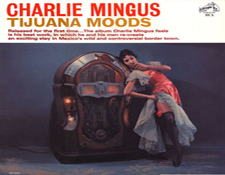It’s the time of year for saving money!
By now some of you, Dear Readers, know I’m a pretty obsessive music collector. Old recordings. New recordings. 45s. 78s. Downloads. Mono. Stereo. Surround sound.
I’m a pan-audiophile…
But I’m also on a budget…
Through it all, I’ve even made my peace with digital audio, with certain caveats.
 I like digital audio just fine with a very qualified “IF” the recording is of a certain high resolution and the producers have made a conscious attempt to make the music sound good. This goes for reissues and first time releases alike.
I like digital audio just fine with a very qualified “IF” the recording is of a certain high resolution and the producers have made a conscious attempt to make the music sound good. This goes for reissues and first time releases alike.
I have some all digital recordings that sound just ducky while others could use a good sonic goose….
I’ve even reached into the bargain bins of low-priced vinyl 180-gram reissues-of-questionable-origin these days. I’ve done this mostly for old jazz and soul albums which are generally pretty rare to find in any condition and if they are in good shape, they are usually quite pricey at collectors used record stores.
What’s that you say? You didn’t know there were low priced 180-gram “reissues-of-questionable-origin” out there?
Yeah, I figured that. Which is sort of what prompted me to write this article.
In recent years, probably because of international copyrights running out, there have been many — many — such albums-of-question appearing in the bins at numerous music stores (real brick ‘n mortar shops as well as online). These are famous albums but some of them appear in covers that are slightly altered from the originals. Or perhaps they don’t have original label designs, thus avoiding trademark infringement issues from reproducing active logo images.
I bring up the point of these records appearing at many stores because that indicates the producers of these things are achieving mass distribution in legitimate channels. Are they pirates? Are they shoddy reissues?
I don’t know, but does it really matter?
No and yes.
Take the case of a copy of Charles Mingus’ 1962 gem called Tijuana Moods.
I bought this for $13 new at Streetlight Records a few years ago. For that price it felt was fair for me to take a chance on a record like that — generally out of print, pricey to find originals, etc. It was also one which I never owned before in any form, so I just wanted to hear the music.
I figured that even if it might have been mastered from a lower resolution digital source such as a CD — one of the frequently cited conspiracy theories of many a collector and audiophile in the online world — the reissue LP would serve a purpose, filling a void in my collection, letting me hear the music in a somewhat analog form. I figured that playing it through my Bellari tube pre amp might warm the sound up a bit more than just playing a regular CD or even an SACD if I could find one.
It worked fine for the first few listens but have to admit that I didn’t really go back to the album very much for some reason. This is not my usual thing with Mingus records, but I never gave it more than a passing thought.
That is, until this past weekend (in which I am writing this review) when happened upon a garage sale being held by a local record collector (and sometimes dealer at places like the KUSF Rock ‘n Swap meet here in San Francsico) who was selling off some albums and 45s. It was there that I picked up a near mint condition original RCA Living Stereo copy of Mingus’ Tijuana Moods album… for four dollars! That is a price I can certainly afford without any potential buyers remorse.
An additional truth to be told: as a collector, I love the thrill of the hunt, finding rare records “out in the wild” as some of us call it… that is… the wilds of flea markets, estate sales, garage sales, junk shoppes, etc. So, yeah, if I really wanted it I probably could have found it at some store for $30-50
But I digress…
Anyhow, lets get back to the digital vs. analog discussion: the first thing I’m noticing about finally hearing this Mingus music on an original RCA Living Stereo pressing is that I feel like I am listening to the music for the first time. The music is warm, swinging and has me fully engaged, aurally, emotionally and mentally.
The drums and cymbals in particular sound so wonderful and real. I’m hearing the sound of the band playing in the studio it was recorded in.
The music in these grooves is alive, man…
Alive, I tell you! (insert Baron Von Frankenstein voice here for maximum dramatic effect).
]]>When a little bell rings on the final track — “Flamingo” — it decays quite naturally, with lovely overtones present. On the 180-gram reissue that bell sort of disintegrates in a choppy manner and generally gets lost to the listener.
And along with losing that sort of detail, you lose some of the air-y feeling that makes an emotional difference in how you hear and appreciate the music. I think that part of that “air” is the dynamic range of the recording, in action…
Objectively, the 180-gram pressing doesn’t sound all that horrible. I mean, for $13 it was sort of ok for the moment and served my purpose in introducing me to the music (albeit not completely satisfactorily, I realize now in retrospect). There is an overall harshness on the high end that I can’t overlook, a harsh edge that I recognize now has made the music harder for me to listen to. The quality of the recording made the actual music less appealing to get into.
That is a pretty big deal, actually…
When a trumpet plays with a mute on the reissue, I’m hearing a cranky, angular tone. On the original pressing, yes the mute still sounds sort of skronky (as that is the flavor of this particular mute) but do hear and feel the warmth of the trumpet — and the trumpet player — coming through in the performance.
The piano sounds rather blocky and flat, somewhat dead even, on the reissue compared to the original pressing which in stark contrast lets you feel the wood of the piano and the notes resonating in the room.
Most importantly, this original pressing makes me want to play the recording over and over.
The reissue does not.
And there in lies perhaps the first time I’ve been able to pinpoint — with some specificity — as to how the audio quality impacts my enjoyment of a recording. Its not the first time this has happened. Most recently I made that connection on U2’s last album — Songs of Innocence — which was notoriously distributed to the masses via MP3 and often viciously slammed in reviews. While I didn’t hate the album as many others did, I admit that I decidedly did not like the sound of the MP3s and thus didn’t play the album more than maybe twice.
However, I found the album really enjoyable when I finally got it on vinyl.
Thus, I think that the medium of choice was the bigger mistake U2 made in distributing its album for free — putting it out as a crummy MP3. That made for a lousy initial listening experience and thus many just wrote it off as a bad record.
It’s not a bad record at all. I suspect that most people just didn’t get to hear it properly. Heck, I don’t think you got to hear the full recording given the cheesy quality of the MP3s distributed.
Next time, U2 should mail out the album on vinyl for free. Send all the fans a 45 RPM single for free and I’ll bet they will get into the music more.
Ultimately, isn’t that what its all about?







